Petroleum
Crude oil is a naturally occurring, yellowish to black mixture of substances in the upper earth's crust, mainly consisting of hydrocarbons, which was formed by the transformation of organic substances. Crude oil is the raw material extracted from a deposit during production and is still untreated.
Already used in the ancient Orient as a fuel, among other things, crude oil has been one of the most important raw materials of industrial society since the first half of the 20th century at the latest. It is not only the most important fossil fuel, but also the most important energy raw material of all. Separation and conversion processes transform crude oil into a variety of intermediate products that serve as the basis for the production of fuels and as raw materials for industry. The latter include, above all, starting materials for numerous products of the chemical industry, such as plastics, varnishes, paints and medicines. Oil is called "black gold" (because of its enormous economic importance). Two politically induced oil price crises have had a significant impact on the global economy. In times of crisis (for example, Great Recession, COVID-19 pandemic), the price of oil has temporarily fallen sharply.
In the years from 2000 to 2009 alone, about 242 billion barrels - one barrel equals 159 liters - were produced worldwide. BP put daily consumption in 2016 at 96.6 million barrels (over 15.4 billion liters), 1.6 percent more than in 2015.
Oil companies such as BP are among the largest economic enterprises in the world. Accidents during production, for example the fire on the Deepwater Horizon oil rig in 2010, or during transport, for example the 1989 accident involving the tanker Exxon Valdez, have caused environmental disasters. The extraction and, in particular, combustion of crude oil release greenhouse gases, which are considered to be the main cause of global warming. Oil transport routes such as the Friendship oil pipeline and their management can be the subject of interstate energy disputes, but also the basis of far-reaching economic developments. Oil prices are important indicators of economic development.
As a fossil fuel, oil is a finite resource. Under the heading of global peak oil, the exhaustion of the world's economically exploitable reserves is being discussed. In 1974 Marion King Hubbert predicted that the global maximum would be reached in 1995 if conditions remained the same. However, with the average oil price rising over the past decades, improvements in extraction technology, and the development of new extraction methods, conditions have changed significantly from the 1970s. Hubbert's forecast, which moreover related exclusively to conventional oil deposits, was therefore repeatedly revised backwards.

Only German drilling platform Mittelplate in the North Sea tidal flats

Closure of an oil-spouting production head damaged by a ship collision

Samples of various crude oils from the Caucasus, the Middle East, the Arabian Peninsula and France
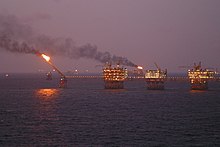
Oil production off the Vietnamese coast
Historical
Word origin
The Babylonians referred to petroleum with the word naptu (from nabatu 'to shine'). This expression indicates that petroleum was used for lighting purposes early on. In ancient Greece, petroleum was known as naphtha (νάφθα) and naphthas (νάφθας) - presumably derived from the Babylonian naptu via the detour of Persian - which are still used today in the term naphtha for crude petrol. Common, however, was also the designation as "oil Medeas" (Μηδείας ἔλαιον Medeias elaion). The latter name probably derives from the fact that it was thought to have been used by Medea for her sorceries, especially in her revenge on Jason.
As rock oil, mountain oil, mountain fat or Peteröle "und in den apotheken petroleum und oleum petrae" or also "St. Catherine's oil", petroleum was already known in Europe in the late Middle Ages. The word petroleum or petrolium, attested in early New High German from the 15th century at the latest, is a Latin compound of ancient Greek πέτρα petra "rock, stone" or πέτρος petros "stone" and oleum for "oil", thus meaning in German "Fels-" or "stone oil". This goes back to the fact that the Ancient Romans in Egypt, in a mountain range on the Gulf of Suez, observed petroleum seeping out of the Nubian sandstone that was found there. The names Bergöl (mountain oil) and Peteröl (Peter oil), which were once common in German, also originated from petroleum. From the 18th century onwards, the present-day designation petroleum increasingly prevailed, and the word petroleum was increasingly used in German from the 19th century onwards for one of its distillation products (see below).
Historical use and promotion
Crude oil has been known for several thousand years. Since it has a relatively low density (0.8-0.9 kg/l or tonnes/m³), which is still below that of water, it can rise to the earth's surface from greater depths in the pore and fissure space of sedimentary rocks in the absence of an upwardly sealing rock layer (in Germany, for example, near Hänigsen between Hanover and Braunschweig). There, the normally relatively thin-bodied oil transforms into a tar-like substance known as bitumen or asphalt through reaction with oxygen and the loss of highly volatile components.
This substance was already known 12,000 years ago in the Near East. Among other things, people used it in shipbuilding for caulking: by mixing the bitumen with sand, reeds and other materials, a mass was created with which the cracks between the wooden ship planks could be sealed. This has also found its way into biblical legends. The Babylonians used bitumen ("earth pitch"), among other things, as a binder in house and road construction. Bitumen was so ubiquitous in the Babylonian empire that Hammurapi devoted several chapters to it in his 18th century BC law book. This is the first recorded state regulation of petroleum.
Petroleum naturally seeping from the earth's surface is also mentioned by the historians of classical antiquity, Herodotus and Pliny the Elder. The Roman army may have used petroleum as a lubricant for axles and wheels. In the early medieval Byzantine Empire, petroleum was probably used to make the fuel for a preliminary form of flamethrower known as "Greek fire."
In pre-industrial modern Europe, petroleum was used in the "preparation of remedies, ointments, etc.", in horticulture to combat pests, and also "for the production of fireworks" and as lamp oil. To increase the "bullet effect", rifle bullets were wrapped together with camphor in a cloth soaked in thin petroleum before being inserted into the barrel. Oils from crude oil wells in Lombardy, such as the "pitch well" on Monte Zibio near Modena, from Pechelbronn in Alsace (cf. Pechelbronn strata) and Upper Bavarian "petroleum", which was sold by the Benedictines of Tegernsee as "Holy Quirin Oil" (named after Quirinus of Tegernsee), were used specifically for therapeutic purposes.
Johann Jakob Lerche, a German-Russian naturalist, observed a flourishing petroleum economy with systematic oil production in the then Persian city of Baku in the mid-1730s.
In the course of the industrial revolution, the demand for lighting, fuel and lubricants grew in Europe, and the importance of crude oil as a cheap alternative to vegetable oils and animal fats increased. In the Galician foothills of the Carpathians, which at the time belonged to the Austrian Empire, Josef Hecker from Prague and Johann Mitis extracted "mountain oil" from shafts near Truskawez in the 1810s. They also succeeded in distilling an easily combustible lamp oil ("naphtha") from it, and the Prague magistrate even decided in 1816 to illuminate the entire city with it, but this failed due to the insufficient Galician production capacities. Around 1853, Abraham Schreiner made experiments with ozokerite, a strongly aliphatic, low-asphaltene depleted petroleum, in a kettle in Borysław and obtained a clear distillate, whereupon he contacted the pharmacist Ignacy Łukasiewicz in Lviv and the pharmacists Jan Zeh. Their collaboration also marked the beginning of continuous oil production in what is now the Polish-Ukrainian foothills of the Eastern Carpathians. An early center of later industrial oil production in underground mining developed further west at Bóbrka, 10 km southwest of Krosno (→ Museum of the Bóbrka Oil and Gas Industry).
A milestone for the modern petrochemical industry is the patent granted to the Canadian physician and geologist Abraham P. Gesner in the USA in 1855 on his process for producing petroleum from oil shale or crude oil. The production of petroleum as an illuminant remained the main purpose of oil production until the rise of the automobile industry in the first decades of the 20th century.
As a result of Gesner's discovery, the systematic large-scale exploitation of oil deposits began in the second half of the 19th century. Although it was already known that oil had seeped into the wells during some deep drilling for brine for salt production, no one had drilled specifically for oil before then. The first oil wells in Germany were drilled in March 1856 in Dithmarschen by Ludwig Meyn and from 1858 near Wietze in Lower Saxony (north of Hanover). The Hunäus well near Wietze, named after the director of the drilling operations, struck oil at a depth of 35 m on July 1, 1859 and is thus considered the first successfully drilled oil well in the world. From a depth of approx. 50 m, around 80 % of Germany's crude oil was extracted in 1910 with 2000 drilling rigs. Today, the German Petroleum Museum is located in Wietze.
The oil well drilled by Edwin L. Drake in 1859 on Oil Creek in Titusville, Pennsylvania, became world famous. Drake was drilling on behalf of American industrialist George H. Bissell and, after several months of fruitless drilling, struck a rich oil deposit on August 27 at a depth of only 21 meters. "That Sunday afternoon on the banks of Oil Creek near Titusville provided the spark that catapulted the petroleum industry into the future." While the Oil Creek area quickly developed into a prosperous oil producing region with many more wells being drilled as a result of this discovery, the Wietze oil discovery was initially of no economic consequence. Therefore, August 27, 1859 and Titusville are considered the more historically significant dates or locations.
In Saudi Arabia, the "black gold" was first discovered near the city of Dammam on March 4, 1938, after a series of unsuccessful explorations by the US company Standard Oil of California.
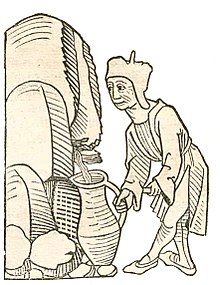
Illustration from the chapter Petroleum in the Hortus sanitatis (one of the "Mainzer Kräuterbücher") from 1491
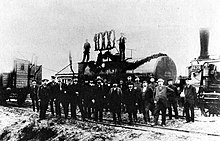
Celebration of the 1000th tanker filled with crude oil in Wietze in 1906
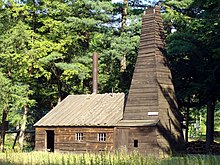
Replica of Drake's well site at the Drake Well Museum in Titusville.
Mining
General
→ Main article: Petroleum production
In general, the production of conventional crude oil today takes place in the following phases:
- In the first phase (primary production), oil is brought to the surface by the natural pressure of the trapped natural gas (eruptive production) or by "pumping".
- In the second phase (secondary production), water or gas is injected into the reservoir (water flooding and gas injection), thereby extracting additional oil from the reservoir.
- In a third phase (tertiary extraction), more complex substances such as steam, polymers, chemicals, CO2 or microbes are injected to further increase the utilization rate.
Depending on the deposit, 10-30% of the existing oil can be produced in the first phase and a further 10-30% in the second phase; in total, therefore, usually 20-60% of the existing oil. When the oil price is high, tertiary production can be worthwhile for "old" deposits.
Oil production from deposits located below the bottom of seas or lakes ("off-shore production") poses particular difficulties. Here, in order to develop the deposit, drilling platforms (drilling rigs) must be set up on the seabed or floating above it, from which drilling and later production (production platforms) can take place. Directional drilling is advantageous here because it allows a larger area to be developed from one drilling platform.
If an oil deposit is located close to the earth's surface, the oil it contains, which has been depleted to bitumen, can be extracted by opencast mining. One example of this is the Athabasca oil sands in Alberta, Canada.
Crude oil is extracted from deeper reservoirs by means of probes that are inserted through boreholes to the reservoir.
After completion of the drilling work, a pure production platform can also be used, example: Thistle Alpha.
Radioactive waste
In general, small amounts of radioactive elements occur in rocks, mostly from the decay series of naturally occurring uranium and thorium, generally referred to as NORM (Naturally Occurring Radioactive Material). In this case, isotopes of radium dissolve together with other elements in deep groundwater, which also occurs as reservoir water in oil deposits, among other things.
During oil production, the reservoir water rises to the earth's surface together with oil and gas in the production pipelines. As a result of the drop in pressure and temperature, barium, calcium and strontium, and with them radium, precipitate in the form of sulphates and carbonates, which settle on the walls of the pipelines. The resulting crusts, known as "scales", accumulate radium over time. In other equipment used for oil production, e.g. water separators, the precipitated sulphates and carbonates are found in sludges, which consist mainly of heavy oil and unintentionally entrained fine mineral components of the reservoir rock. The long-lived 226Ra (1600-year half-life) is particularly problematic here.
According to research by WDR employee Jürgen Döschner, millions of tons of such NORM-contaminated residues are produced annually worldwide during oil and gas production, of which up to 2,000 tons are produced in Germany from 3 million tons of oil. The specific activity varies relatively strongly, but in the case of the 226Ra contained in "Scale" it can be up to 15,000 becquerels per gram (Bq/g), which is in the range of the specific activity of uranium.
Although, according to the Radiation Protection Ordinance of 2001, substances are subject to monitoring already from 1 Bq/g (roughly corresponding to the upper range of the natural radioactivity of granite) and must be disposed of separately, the implementation of this ordinance was left to the industry's own responsibility, as a result of which at least some of the waste was apparently handled or disposed of carelessly and improperly. In one case it is documented that waste with an average of 40 Bq/g was stored openly on a company site without any labelling and was also not to be specially labelled for transport.
In countries where significantly more oil or gas is produced than in Germany, significantly more waste is also produced, but in no country is there an independent, continuous and complete recording and monitoring of contaminated residues from oil and gas production. The industry deals with the material in different ways: In Kazakhstan, according to Döschner, an area the size of the Federal Republic of Germany is said to be contaminated, while in Great Britain the radioactive residues are simply discharged into the North Sea. In the USA, for a long time, mainly NORM waste with a high oil content was applied to the surface of the land in the thinnest possible layers for the bacterial degradation of the hydrocarbon fraction, usually in the immediate vicinity of the production facilities (so-called "landspreading"). The resulting health risks associated with future land use in these areas are considered to be rather low. However, the case of Martha, a community in the US state of Kentucky, shows how much the risk potential of radioactively contaminated oil production equipment was sometimes underestimated or ignored. There, the company Ashland Inc. had sold thousands of contaminated production pipes cheaply to farmers, kindergartens and schools after the Martha oil field was shut down. Radiation doses of up to 1100 microroentgens per hour occurred at some of these pipes, which were used to build fences or climbing frames, so that the elementary school and some homes had to be evacuated immediately after the radiation was discovered.
World reserves and stockpiling
For crude oil, the static range is relatively short and subject to considerable fluctuations. For example, it was estimated at 20 years immediately after each of the two world wars. Despite considerably higher consumption and very dynamic economic and technological development, it increased thereafter. After a crisis in the 1970s, it was set at 25 years. After that it rose to a value of 30 until today 40 or even 50 years according to today's state of the art and oil price level. This constancy of the range is also called the oil constant. It refers to the fact that, as with other commodities, predictions of the static range of crude oil have to be regularly adjusted due to the discovery of further deposits and in view of advances in production technology as well as market price movements.
At the beginning of the 2000s, the world's largest reserves were still located in Saudi Arabia. However, because the costs of extracting unconventional oil deposits, such as oil sands or heavy oil, have now fallen to the point where they are close to the costs of conventional oil production, and because oil prices have risen since the turn of the millennium, such unconventional deposits are now added to a country's oil reserves. Therefore, in 2013, the largest oil reserves were in Venezuela (298.3 billion barrels - of which 220.5 were in the Orinoco heavy oil belt), followed by Saudi Arabia (265.9), Canada (174.3 - of which 167.8 were oil sands), Iran (157.0) and Iraq (150.0) (see Petroleum - Tables and Charts: Reserves by Country for a detailed table).
According to the 2006 energy study of the Federal Institute for Geosciences and Natural Resources, there is sufficient availability of oil without the inclusion of unconventional deposits until about 2020. According to a Science article (2004) by Leonard Maugeri of Eni, on the other hand, the age of oil is far from over, whereas Murray & King argued in Nature in 2012 that the production maximum (peak oil) of conventional crude oil had already occurred in 2005. This can be seen from a change in the price elasticity of production.
For 2008, confirmed world reserves were calculated to be 1329 billion barrels (182 billion tonnes according to ExxonMobil's Oeldorado 2009) or 1258 billion barrels (172.3 billion tonnes according to BP Statistical Review 2009), depending on the source. Reserves that are located and can be economically extracted with the technology available today have increased slightly in recent years, despite the overall annual production volumes. While reserves in the Middle East, East Asia and South America declined due to depletion of deposits and insufficient prospecting activity, they increased slightly in Africa and Europe.
After several years of high oil prices in the order of $100 per barrel, prices fell in the second half of 2014 to barely more than $40 in January 2015. Experts blamed a supply overhang for this price plunge. Following Iran's return to the market in January 2016 and the battle for regional supremacy by Saudi Arabia in this context, as well as due to Russia's failure to curb production, it was foreseeable that the oversupply would last for some time at a price now around 50 dollars.
The countries of the European Union are obliged to maintain a 90-day supply as a strategic oil reserve for times of crisis. A large part of the German and a smaller part of the foreign stocks are located in the underground cavern facilities in the Zechstein salt in the Wilhelmshaven area, through whose oil port a fifth of Germany's oil requirements are imported. In Austria, this task is the responsibility of the Erdöl-Lagergesellschaft.
| World oil reserves 2013 in billion barrels | |
| Region / Organization | BP estimate 2013 |
| OECD | 248,8 |
| CIS | 131,8 |
| China | 18,1 |
| Asia-Pacific | 42,1 |
| Latin America | 329,6 |
| Middle East | 808,5 |
| Africa | 130,3 |
| World | 1687,9 |
With daily consumption at the current level of about 90 million barrels (as of 2014), 1687.9 billion barrels of reserves gives a range of about 51 years. However, when assessing this figure, one must bear in mind that petroleum shortages do not occur only after the (static or dynamic) range of petroleum has expired. This is because, unlike from a tank, arbitrary quantities of oil per day (production rate) cannot be withdrawn from oil deposits. Rather, there is a maximum possible production rate, which is often reached when the well is about half exploited. After that, its production rate drops (due to physics). A similar behavior is assumed by many experts for the world's oil production: After reaching a global production maximum ("peak oil", see above), the global production rate declines. In purely mathematical terms, there is still enough oil available at this point in time to cover current daily consumption, even if this is even increasing compared to today, but the oil cannot be extracted from the deposits sufficiently quickly and is therefore not available to the economy. The finite nature of oil as a resource makes itself felt long before its lifetime expires. The lifetime of oil calculated here is therefore of little economic significance; what is more interesting is the time course of the global production peak and the extent of the subsequent decline in production.
Critics of such reserve data point out, however, that most of the reserves from non-OECD countries are not subject to independent control (see footnotes of the BP statistical review). Often (as in Saudi Arabia) all information on production data for individual fields and reserves is subject to state secrecy. Critics therefore accuse these figures of being falsified. Many OPEC producer countries are also accused of overstating their reserves, since the production quotas allocated depend on the reported reserve quantities.
World funding
The most important oil producing countries are currently (as of 2013) Saudi Arabia (11,525,000 barrels/day; 13.1 % of world production), the Russian Federation (10,788,000; 12.4 %), the USA (10,003,000; 11.5 %), the People's Republic of China (4,180,000; 4.8 %) and Canada (3,948,000; 4.6 %). The twelve OPEC countries currently account for 42.5% of world production at 36.8 million barrels/day. In 2009, Russia was still the largest producer (10,139,000 barrels/day; 12.5 % of world production), followed by Saudi Arabia (9,663,000; 11.9 %), the USA (7,263,000; 8.9 %), Iran (4,249,000; 5.2 %) and China (3,805,000; 4.7 %) (see also Petroleum - Tables and Charts: Production). Crude oil production in Germany originally covered up to 80 % of national demand and was historically of great importance, but now only accounts for 2 %.
According to Abdallah Jumʿa in early 2008 (then CEO of Aramco), around 1.1 trillion barrels of oil have been produced in human history. Most of the reserves were discovered in the 1960s. As of the beginning of the 1980s, annual production (2005) is 30.4 billion barrels (87 million barrels per day of consumption in 2008) - above the capacity of newly discovered reserves, so since that time existing reserves have been declining.
That is why some experts expect global production to peak between 2010 and 2020. Kenneth Deffeyes, Colin J. Campbell and Jean Laherrere fear that the maximum will already have been reached before 2010. One consequence of this production maximum would be a subsequent fall in production, so that the demand forecast in parallel with economic growth would no longer be adequately met.
The British government, the U.S. Department of Energy and the U.S. Joint Forces Command, the central analysis service of the U.S. Armed Forces, issued increasingly critical analyses in which threatening shortage scenarios were described in the short term. The British government was obviously reacting to the fact that England's oil wealth had been steadily declining since 1999, and in 2006 it went from being an oil exporter to an importer.
Dschumʿa rejects such fears. He estimates that of the existing liquid oil reserves, less than 10% have been produced and (including non-conventional reserves) oil will be available for at least another 100 years at current consumption rates.
Whereas in the 1970s private Western oil companies still controlled almost 50 percent of global oil production, this share has fallen to less than 15 percent in 2008. By far the largest share is produced by state-owned companies. Experts do not consider there to be a shortage of oil, but rather a crisis in access to advanced technology (by the multinationals) or, conversely, a lack of investment security in the state-controlled oil-producing countries.
See also: Oil production
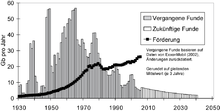
Oil discoveries from 1930 to 2050 and production until 2001, source: ASPO

Crude oil prices (nominal and real) since 1861
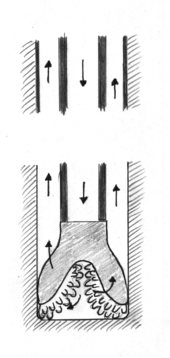
Oil well with drill bit, longitudinal section, schematic, cased at the top
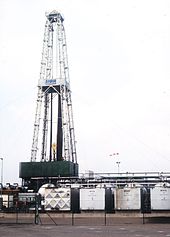
Drilling rig with pipe string sections, next to it container for the drilling fluid
Questions and Answers
Q: What is petroleum?
A: Petroleum, also known as crude oil, is a thick and black liquid made of mostly hydrocarbons.
Q: Where is petroleum found?
A: Petroleum is mainly found by drilling down through rocks on land or off-shore on the continental shelf. Major producers are in the Middle East, the Americas, and Russia.
Q: How important is petroleum as an energy source?
A: Petroleum supplies 38% of the world's energy and is the most important world fuel source.
Q: How does crude oil become useful mixtures?
A: Crude oil is separated into simpler, more useful mixtures by fractional distillation in oil refineries to give separate chemicals such as gasoline (or petrol) for cars, kerosene for airplanes and bitumen for roads.
Q: What color does bitumen give to crude oil?
A: The bitumen gives crude oil its dark black color; most of the other chemicals in crude are slightly yellow or colorless.
Q: How can petroleum be transported?
A: Petroleum can be easily transported by pipeline and oil tanker.
Q: What are some uses of refined petroleum?
A Refined petroleum is used as fuels; mainly gasoline (petrol) for cars, diesel fuel for diesel engines used in trucks, trains and ships, kerosene fuel for jets and as lubricants. It also used to make petrochemicals
Search within the encyclopedia